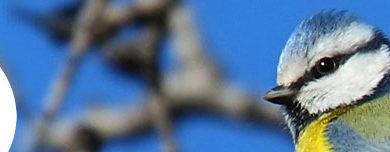The Olympus National Park Information Center
Before you visit the Olympus National Park, it is a good idea to look at the Olympic National Park Information Center. It was opened in June 2016 and is located just outside the village of Litochoro. Follow the signs that lead you to the peaks. After about 800 meters you find the building, opposite the sports complex, on the right side of the road (N 40.110090, E 22.499050).
At the entrance I was kindly received and informed by Savvas about the purpose of the facility. In addition to the education of pupils from all parts of Greece, it serves as a starting point for all people who are interested in the Olympus. It is run by the Greek National Park Administration.
Savvas takes the time to accompany me through the exhibition. A four-piece polyptych shows the third-highest peak, the Stefani (2909 m), at night (see above), embedded in a sea of stars. A sight which unfortunately is mostly denied us at sea level. Through the evaporation, a veil filters down the stars.
The exhibition is divided into seven areas, in which the peculiarities of the seven different zones of the mountain are represented. Spread over several stages, you will find large-sized tablets, which provide information on various topics in Greek and English. Many screens are available for interactive exploration. An interesting idea has been realized here: each rise in the exhibition will show the next high altitude of the mountains and show the prevailing flora and fauna. U-shaped, the corridor leads upwards to end over the polyptych of the entrance.
Let's take a closer look at the most important stations. First we go to a small cinema. Here the visitor gets a 3D glass and sees in an approx. four-minute animation in Greek or English language the emergence of the Olympus, its sights and some history. Unfortunately, this film is not available on the Internet. By the representation in 3D is also a good video recording is not possible. But if you are content with the sound, you can listen to it here (in English):
The next highlight will be a touchscreen, with which the visitor can look at the mountains from certain points. Choose the desired location and enjoy a 360 ° all-round view from there. A few steps further, at the foot of the mountain in the altitude of 300m - 500m, in addition to the typical animals and plants of this region are also different types of stones of the mountains presented. In showcases one sees branches and fruits of the trees growing here. Anyone interested in the geological structure should look here .
After you have swept a lot of heights without gasping, you are faced with two impressive picture charts. One of them shows animals, the other is dedicated to plants. The most impressive fauna is the brown bear, which can be seen occasionally, the wolf and the chamois, which can be observed in winter in associations of up to 100 animals. To the left of the large vestibules is a portrayal of Vasilis Ithakisios' cave. With the famous mountaineer Christos Kakkalos he climbed the peaks in 1928. From what he saw, he was so impressed that he retired to a cave over summer to capture the beauty of the mountain in his pictures. As there were no mountain huts at that time, hikers and mountaineers were happy to be able to spend the night in his cave. In 20 years he painted more than 500 pictures of his beloved Olympus. Almost 100 years old he died, his bones are buried in his cave under a gravestone.




